The Intel Broadwell Desktop Review: Core i7-5775C and Core i5-5675C Tested (Part 1)
by Ian Cutress on June 2, 2015 7:45 AM ESTOffice Performance
The dynamics of CPU Turbo modes, both Intel and AMD, can add a wrinkle to testing in environments with a variable threaded workload. There is also an added issue of the motherboard remaining consistent, depending on how the motherboard manufacturer wants to add in their own boosting technologies over the ones that Intel would prefer they used. In order to remain consistent, we implement an OS-level unique high performance mode on all the CPUs we test which should override any motherboard manufacturer performance mode.
All of our benchmark results can also be found in our benchmark engine, Bench.
Dolphin Benchmark: link
Many emulators are often bound by single-threaded CPU performance, and general reports tended to suggest that Haswell provided a significant boost to emulator performance. This benchmark runs a Wii program that raytraces a complex 3D scene inside the Dolphin Wii emulator. Performance on this benchmark is a good proxy of the speed of Dolphin CPU emulation, which is an intensive single core task using most aspects of a CPU. Results are given in minutes, where the Wii itself scores 17.53 minutes.
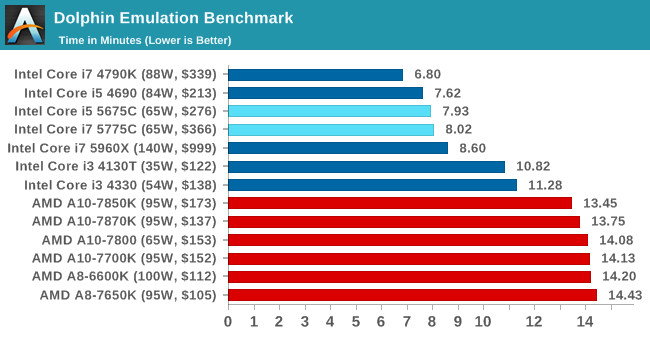
Crystal Well doesn’t help much in Dolphin, indicating it is more CPU frequency limited than DRAM/cache limited.
WinRAR 5.0.1: link
Our WinRAR test from 2013 is updated to the latest version of WinRAR at the start of 2014. We compress a set of 2867 files across 320 folders totaling 1.52 GB in size – 95% of these files are small typical website files, and the rest (90% of the size) are small 30 second 720p videos.
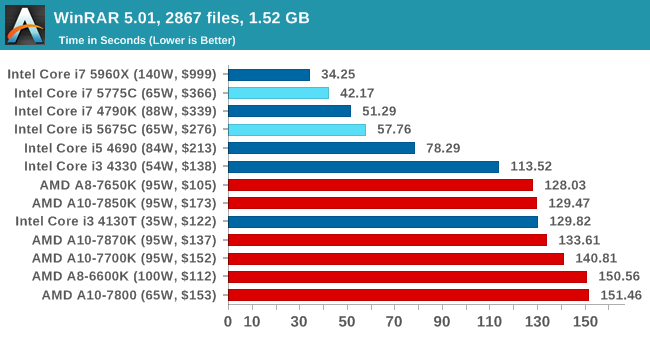
WinRAR is our typical benchmark to go to when testing whether DRAM is factor, and the improvements provided by the Crystal Well implementation trump any frequency deficit.
3D Particle Movement
3DPM is a self-penned benchmark, taking basic 3D movement algorithms used in Brownian Motion simulations and testing them for speed. High floating point performance, MHz and IPC wins in the single thread version, whereas the multithread version has to handle the threads and loves more cores.
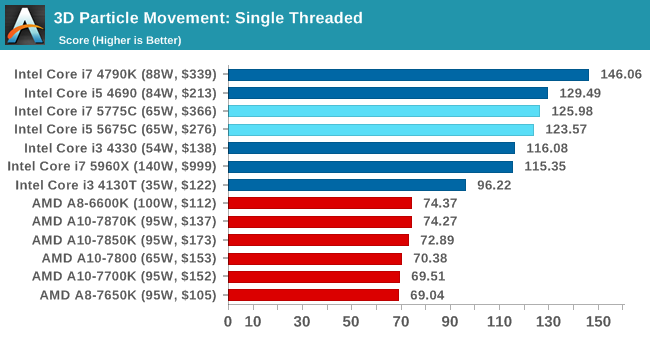
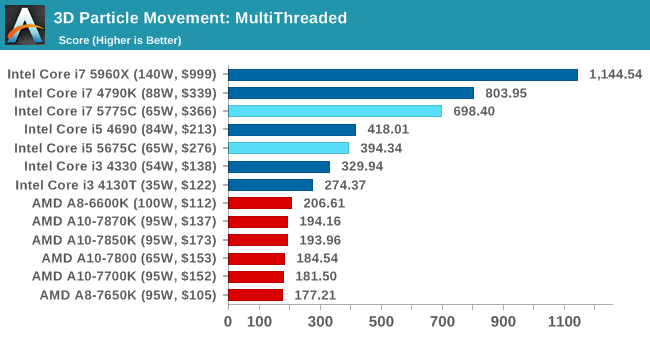
3DPM, like Dolphin, is concerned more with CPU frequency than DRAM accesses.
FastStone Image Viewer 4.9
FastStone is the program I use to perform quick or bulk actions on images, such as resizing, adjusting for color and cropping. In our test we take a series of 170 images in various sizes and formats and convert them all into 640x480 .gif files, maintaining the aspect ratio. FastStone does not use multithreading for this test, and results are given in seconds.
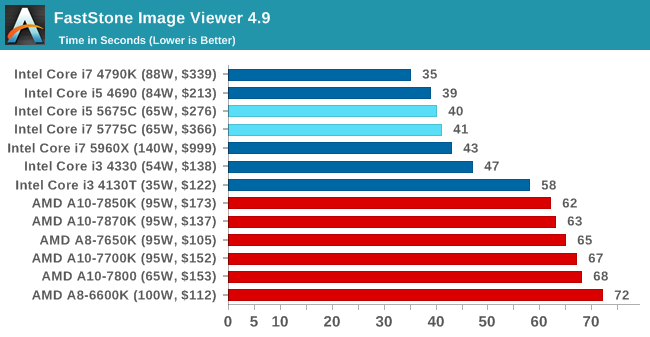
Web Benchmarks
On the lower end processors, general usability is a big factor of experience, especially as we move into the HTML5 era of web browsing. For our web benchmarks, we take four well known tests with Chrome 35 as a consistent browser.
Mozilla Kraken 1.1
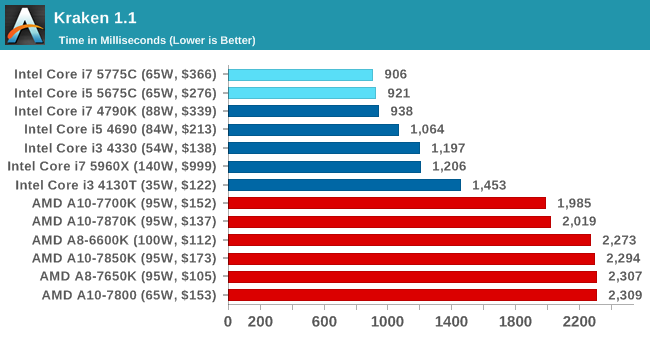
WebXPRT
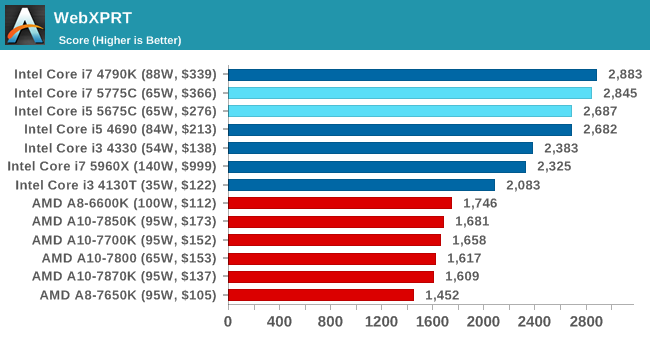
Google Octane v2

In the webtests, the Broadwell-DT CPUs didn’t necessarily take top spot but they are punching above their expected weight for their frequency.










196 Comments
View All Comments
HotRod917 - Tuesday, June 2, 2015 - link
Hahaha.."lay the smackdown"..on Broadwell's candy A#$..! good one ;)Asomething - Tuesday, June 2, 2015 - link
So can you guys include 2400mhz ram in part 2 gaming benchmarks? it would be interesting to see what both sides gain from the faster ram.bobjones003@gmail.com - Tuesday, June 2, 2015 - link
Well I see no reason to upgrade yet maybe when skylake drops. My sandy bridge(i 5 2500k) will go for another generation. The cpu runs overclocked to 4.7 ghz at this I could save boat load of power on the system.Shadowmaster625 - Tuesday, June 2, 2015 - link
This review is also bunk due to the fact that they are usign a DDR3 card when even the same card with GDDR5 is way faster and only marginally more expensive. No one in their right mind even buys a gpu with DDR3 onboard.bloodypulp - Tuesday, June 2, 2015 - link
5 Years after the first AMD APU with graphics on-die, Intel finally has graphics on die.Well done Intel. *slow clap*
Peichen - Tuesday, June 2, 2015 - link
And AMD market share on CPU and GPU have been going from what to what in those 5 years? Kinda like how Bulldozer was the first "true" quad-core but managed to run at 60% of the speed of "fake quad" Q6600 and being hot as hell.bloodypulp - Tuesday, June 2, 2015 - link
Process advantage, much of it.olafgarten - Tuesday, June 2, 2015 - link
Technically Intel did graphics on-die first, they did it back in January 2010 with HD Graphics on the Clarkdale and Arrandale. It was in June 2011, when AMD released their first APU.Ryan Smith - Wednesday, June 3, 2015 - link
Clarkdale was a separate GPU die, on-package with the CPU. Intel didn't integrate the GPU on to their CPU until Sandy Bridge in January of 2011.HotRod917 - Tuesday, June 2, 2015 - link
Hey whats the whole"Thank you A for X
Thank you B for Y"...huh, whats goin on AT? Dare i say sarcasm towards manufacturer's being cry babies for not thanking them enough.
And speaking of manufacturer's...AMD its high time u pull a miracle (zen) and 'bring it, I mean the monopoly from the blue team is just ridiculous...for god sake AMD plz. Also ARM and Samsung ur welcome to join the desktop x86 party anytime..and the sooner the better.
Meanwhile i'll be rockin my delidded 3570k till skylake is out